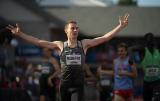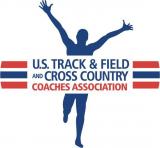Folders |
Clayton Murphy Has a Season To Remember Culminating in an Olympic Bronze - DyeStatCOLLEGEPublished by
Murphy’s development beyond expectationsPublished by Adam Schneider/DyeStatCOLLEGE.com Editor on December 21st, 2016
Many athletes came into 2016 with impressive credentials and signs of improvement that pointed to big seasons. One athlete who surprised experts and fans alike by his level of improvement last year was Akron junior Clayton Murphy. His season was inspiring, but how he did it might be revolutionary for most of the country. For Murphy, 2017 was supposed to be the big year. He originally wanted to come back for cross country – he is a team guy – but a successful 2016 college season and the temptations were too great with a professional running contract. When Murphy arrived in Akron as a freshman, he and Zips coach Lee LaBadie had outlined a long-term plan and he was well ahead of schedule in 2015 following a Pan Am Games 800-meter win (1:47.19), a silver medal at the North American, Central American and Caribbean Championships (1:46.38) and a sixth-place finish in his semifinal (1:46.28) at the Beijing World Championships. Murphy built on that momentum in March with an indoor NCAA 800 title (1:46.68), all in personal records. By the 2016 NCAA outdoor championship meet, no one was sure how well he would do in the 1,500 – 3:44.21 was his season best – but the top challengers were afraid of his 4x400 relay split of 45.6 and his indoor NCAA 800 win. Izaic Yorks of Washington and Henry Wynne of Virginia pushed the pace early in the final, with Murphy following close behind. Behind an impressive last lap, Murphy pulled away from Yorks and Wynne to capture the NCAA 1,500 title in 3:36.38, with the final boasting the three fastest collegians in a collegiate-only race, as all 3 broke 3:39. After signing a Nike contract, Murphy nearly met the Olympic qualifying standard of 3:36.20 at the Portland Twilight with his 3:36.23, but he was too tired to make the push over the final lap (he ran 15s, 15s, 15s for the first three 100s over that last lap). Following his 800 victory at the Olympic Trials in 1:44.76, Murphy had no plan to race again before competing in Rio de Janeiro, but was entered into the 1,000 at Houston on July 23 and beat eventual Olympic 1,500 champion Matthew Centrowitz, 2:20.12 to 2:20.20, again using his strong kick. At the Olympics, he got bumped in round one and had to qualify on time in 1:46.18. In the semifinals, he stayed close to the front and near the rail and qualified easily in a new PR of 1:44.30. Murphy employed the same strategy in the final, but was back in sixth in a fast race and followed the move by defending Olympic 1,500 champion Taoufik Makhloufi with 200 meters to go. Murphy passed teammate Boris Berian and in the last 50 meters, caught early leader Pierre-Ambroise Bosse and moved into third, finishing in 1:42.93, the third-fastest time ever for an American. The big question is how did he get this fast so quickly, after running 1:54 and 4:11 in high school? Murphy ran only 20-30 miles per week at Tri-Village OH and he didn’t do abdominal or core work or do the little things to be better, such as icing, stretching, or regular sleep. “I noticed him his junior year at state (track),” LaBadie said. “At the regional cross country meet, I saw him run cross country and I could tell right away this was a special guy that could make NCAAs and be top-three by (his) senior year.” LaBadie had coached former steeplechase national champions Mark Croghan and Robert Gary. “I’m not a novice to seeing someone’s form and how they run,” LaBadie said. “I knew that Clayton was one of those (special runners). How he would run foot forward, his smoothness, rhythm, efficiency of motion, you could see he was a good runner. His speed is already there from his junior time in the mile.” LaBadie knew that Murphy was untapped. “He grew up in a New Paris farm,” LaBadie said. “He didn’t have a lot of people to train with.” After recruiting Murphy to attend Akron, LaBadie found even more to like. “I like to say Clayton has qualities that a champion has, innate qualities developed by a family with a great upbringing,” LaBadie said. “One of the keys is that Clayton was a very big team guy, soccer, basketball, and cross country.” During Murphy’s junior year at Tri-Village, Cory Glines – now at Northern Arizona – won the 1,600 for St. Thomas Aquinas OH in a state meet record 4:12.93. Murphy responded by working harder and beat Glines in his senior year, lowering the record to 4:11.72. Before Murphy started college classes, he and LaBadie discussed that he would eventually run 1:48 and people he knew laughed at him. In training, he started doing the little things, abdominal work and improved nutrition, in addition to increasing his mileage. LaBadie helped Murphy get used to running more miles and in the process gain the strength for rounds in the 800. LaBadie looked at two-time 1,500 Olympic champion Sebastian Coe (50 miles per week) and 800 Olympic champion Steve Ovett (120 per week) as examples of how limited mileage and high mileage can help middle distance runners and the symbiotic relationship between the 800 and 1,500. Coe had set world records in races from 800 to the mile, but had Olympic 1,500 victories (and 800 medals) in 1980 and 1984. Ovett set world records in the 1,500 and mile, but won the 800 at the 1980 Olympic Games. To build up strength, LaBadie increased Murphy's mileage but did not just continue to escalate from month to month. Instead, he varied the mileage weekly like he had done with Croghan. Although Croghan had been running 80 miles per week, LaBadie dropped his miles to 60 per week and the ensuing weeks would fluctuate, sometimes maxing out at 80, but then dropping to as few as 50. Croghan had been ninth at the U.S. championships, but then started winning titles and going to international championships. The same thing happened with Gary. “Most champions have points that are not as strong as their competition and they get beat. Those points have the potential to get stronger,” LaBadie said. “To address a weak point, we will set up a workout that would help make a weak point not a weak anymore. For difficult points, we will put an athlete in a race situation so they understand how they feel, and then they can relax. In order to relax and work their hardest, it is a skill they need to understand how to do. Otherwise they won’t continue to succeed.” Murphy ran well in his freshman cross country season with a 13th-place finish (25:29.4 for 8 kilometers) at the 2013 Mid-American Conference championships and he was 43rd (31:32.0) at the NCAA Great Lakes Regional. Nerves got the better of Murphy during his first few races indoors, producing miles of 4:22.93 and 4:20.04. In consecutive days in February, he ran a 1:50 split for the Zips’ 4x800 and also ran a 4:10.87 mile. Two weeks later, Murphy ran 4:02.94 to win the Spire Invitational, then finished his indoor campaign by winning the MAC title in the mile (4:08.69) and was runner-up in the 3,000 (8:20.93). “Clayton is always able to give feedback,” LaBadie said. “When he was a freshman he would say he was tired. Two-thirds of the time I am looking at form and how hard they are running. There is no sense in pushing an athlete beyond their limits. Athletes must communicate and a coach must focus on not overtraining.” Murphy steadily improved during his freshman outdoor season, running 1:50.03 and 3:44.53 – the latter to win his heat at the Mt. SAC Relays – and won the MAC 1,500 title (4:02.38). His sophomore cross country season led to a fourth-place finish at the MAC championships (24:58.1) and 23rd-place finish at the NCAA Great Lakes Regional (30:43.0). During his sophomore indoor track season, Murphy focused more on the 4x400 relay and dropped his 800 PR to 1:47.82, before winning the 800 (1:53.10) and mile (4:09.09) titles at the MAC Championships. He finished third (1:47.06) at the NCAA Championships. Murphy ran the same races outdoors and finished third (1:49.52) at the NCAA final. He truly hit his stride with a great summer in 2015 and came back to Akron with a plan that paid off with a 2016 Olympic bronze. “As he trains and races and makes mistakes, if he doesn’t win, he will look at that and try to examine what does he need to do to improve,” LaBadie said. “Not everyone reviews their performances in an analytical way. The key is Clayton looks at his race tactics, did he execute them the right way? If he is in shape and he is not pulling away with 400 to go, is he not trying or out of shape?” LaBadie applies the same analytical approach and the relationship works well. “Clayton always believed he could accomplish high goals. He is not afraid. He asks what are the intermediate steps,” LaBadie said.“He has had some fantastic experiences (now) himself and knows the path.” LaBadie and Murphy agreed that the tight turnaround at the Olympics from 800 to 1,500 would be tough to do since 1,500 heats were the morning after the 800 final. When Murphy did not get the Olympic qualifying time for the 1,500 before the Olympic Trials, it made the choice an easy one. When the timing is right in the future, the next step in Murphy’s progression will be to tackle the double in the U.S. and internationally. More news |








